5T15C变速器维修手册
- 格式:pdf
- 大小:716.59 KB
- 文档页数:8

比亚迪速锐变速箱维修手册5T-14手动变速器维修手册第一节结构参数1.1变速器结构参数第二节检修准则2.1检修材料下表所列出的材料,在维修本型号变速器时是必不可少的。
因此,应当随时准备,以备使用。
此外,洗涤液和润滑油也应尽量使用规定的型号。
辅助材料表:2.3检修守则准备好零件箱以及零件架,用来放置拆卸、分解的零部件,放置时必须有次序,必要时做上标记,避免发生混乱、放错。
检修铝合金部件时要十分小心,避免加工表面的损伤。
准备好充足的辅助材料,以便在检修时随时取用。
对有标准拧紧力矩要求的螺栓和其它紧固零件,按照要求数值使用专用工具拧紧。
进行检修后,一次性用品应当报废,换上新品。
使用正确的拆卸工具进行拆卸与装配。
工作时尽可能参照本检修手册的内容。
检修时如果遇到难以解决的技术问题,建议向我公司技术索赔一部咨询。
第三节变速器的检修3.1变速器的分解前箱体—分解图(1)差速器组件(2)倒档锁凸轮组件(3)安装螺栓(15N·m)(4)换档拨叉组件(5)副轴组件(6)主轴组件(7)磁铁组件(8)滑动轴套(9)圆柱滚子轴承(10)机油导向板2(11)58mm深沟球轴承(12)主轴油封(13)倒档齿轮轴(14)空转齿轮组件(15)安装螺栓(15N·m)(16)倒档轴拨叉组件(17)定位销(18)防尘罩(19)分离臂(20)分离臂螺钉(30N·m)(21)分离臂弹簧(22)分离轴承(23)差速器右油封(24)拉索支架(25)六角法兰面螺栓M8×45(25N·m)(26)六角法兰面螺栓M6×22(10N·m)(27)车速传感器组件(28)O型密封圈(29)车速传感器从动齿轮(30)弹簧(31)8mm垫圈(32)卡簧(33)8mm弹簧垫圈(34)拨叉轴螺钉(25N·m)(35)变速器前箱体后箱体—分解图(1) 限位螺栓(22N ·m ) (2) 限位弹簧 (3) 钢球(4) 12mm 平垫圈(5) 排放塞(39N ·m ) (6) 14mm 平垫圈(7) 密封螺塞(25N ·m ) (8) 六角法兰面螺栓M8×40(25N ·m )(9) 螺栓M8×45(25N ·m ) (10)离合器高压钢管固定支架 (11)分离泵油管固定支架 (12)六角法兰面螺栓M6×8(10N ·m ) (13)机油导向板1(14)72mm 垫圈 (15)排油槽板 (16)80mm 垫圈(17)倒车灯开关垫片(18)倒车灯开关组件(30N ·m ) (19)六角法兰面螺栓M6×20(10N ·m ) (20)手动换档总成 (21)圆柱销(22)20mm 平垫圈(23)注油塞(45N ·m ) (24)差速器左油封(25) 空档开关组件(35N ·m )(注:装备空档开关组件的变速器适用)注意:将变速器前箱体用两个厚度足够的的木块垫起,防止主轴撞击到工作台。

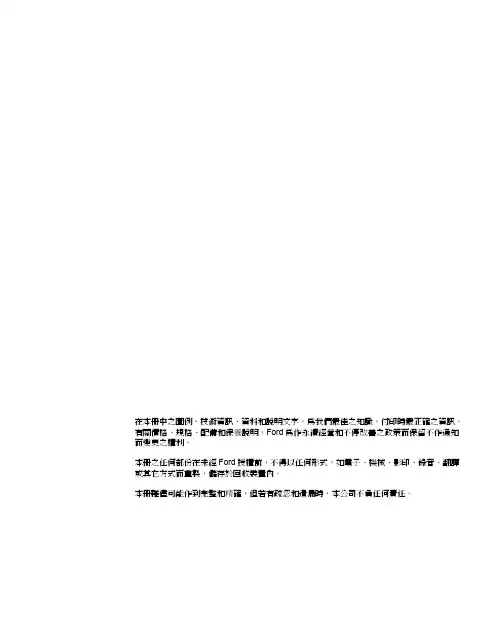
在本冊中之圖例、技術資訊、資料和說明文字,為我們最佳之知識,付印時最正確之資訊。
有關價格、規格、配備和保養說明,Ford 為作永續經營和不停改善之政策而保留不作通知而變更之權利。
本冊之任何部份在未經Ford 授權前,不得以任何形式,如電子、機械、影印、錄音、翻譯或其它方式而重製,儲存於回收裝置內。
本冊雖儘可能作到完整和精確,但若有疏忽和遺漏時,本公司不負任何責任。
维修技术资信网ww w.sy sx zl .c omQQ :車型年份2002.50Mondeo 採用-5速自排變速箱,此變速箱衍生自Galaxy 之5速自排變速箱。
但兩變速箱間仍有數個明顯差異,故學員資訊中對此提供詳細說明。
5前進檔和倒退檔之檔位由排成二平面三簡單式行星齒輪組來達成。
齒輪組可用自動或直接由駕駛者以選擇換檔模式來換檔。
並經由一獨立變速箱控制單元進行電子控制。
在剛開始一年,此變速箱不作維修設計,但除了各油封、主控制閥體、個別之電磁閥、扭力轉換器和變速箱檔位(TR)感知器以外。
本學員資訊提供-變速箱之概論。
包含變速箱內各元件組、不同檔位和動力流程以及變速箱控制系統設計和功能之詳細說明。
此外,概論內容亦包含變速箱油冷卻系統和外部之控制。
本學員資訊區分為數個單元,並依新的Ford 訓練概念設計成自我學習之工具。
各單元之開頭將列出經由該單元學習後可達到之目標。
各單元之結尾將有一組測驗問題,以監測學員之程度。
這些測驗題之解答在學員資訊之後面。
請記得我們的訓練方式僅供作FORD 訓練目的用。
維修和調整作業務必依工作手冊之說明和規格來實施。
請多利用Ford 技術訓練課程提供之訓練課程以得到更多之理論和實務知識。
维修技术资信网ww w.sy sx zl .c omQQ :前言...........................................................................................................................1目錄...........................................................................................................................2單元1-自排變速箱-車輛配備:5速自排變速箱變速箱說明 (7)概述 (7)變速箱橫剖面圖......................................................................................................................10扭力轉換器與扭力轉換器鎖定離合器(TCC) (12)機油泵浦 (13)第1和第2行星齒輪組..........................................................................................................14減速行星齒輪組. (16)離合器和制動帶 (18)差速器總成.............................................................................................................................20主控制閥體.. (22)辨識標籤 (24)變速箱檔位和動力流程 (24)作動概論 (25)變速箱1檔 (26)1檔之動力傳輸路徑...............................................................................................................28變速箱2檔.............................................................................................................................302檔之動力傳輸路徑 (32)维修技术资信网ww w.sy sx zl .c omQQ :變速箱3檔.............................................................................................................................343檔之動力傳輸路徑...............................................................................................................36變速箱4檔.. (38)4檔之動力傳輸路徑 (40)變速箱5檔.............................................................................................................................425檔之動力傳輸路徑 (44)變速箱倒檔 (46)倒檔之動力傳輸路徑 (48)變速箱電子控制系統 (49)概論........................................................................................................................................50變速箱控制單元. (52)換檔方式 (53)CAN 網路資料匯流排之信號傳送 (57)渦輪軸速度(TSS)感知器 (59)中間軸速度感知器..................................................................................................................60輸出軸速度(OSS)感知器.. (61)變速箱油溫度(TFT)感知器 (62)變速箱檔位(TR)感知器...........................................................................................................63選擇換檔開關. (64)停車燈開關 (66)剎車壓力開關 (67)主控制閥體內電磁閥概述.......................................................................................................68主調整閥 (69)维修技术资信网ww w.sy sx zl .c omQQ :PWM 電磁閥-2檔/4檔/5檔制動器......................................................................................70PWM 電磁閥-3檔-5檔離合器. (71)PWM 電磁閥-扭力轉換器鎖定離合器(TCC) (72)換檔電磁閥SSA 、SSB 和SSC (73)換檔電磁閥-減速制動帶.......................................................................................................74換檔電磁閥-空檔接合.. (75)排檔桿鎖定電磁閥 (76)點火鑰匙取出抑制器電磁閥....................................................................................................77儀錶板 (78)通用電子模組(GEM) (79)倒車燈繼電器 (80)變速箱電子控制系統 (80)油位檢查 (81)TR 感知器調整 (82)測驗題.....................................................................................................................83單元2-變速箱冷卻-車輛配備:5速自排變速箱變速箱冷卻 (87)冷卻迴路 (88)測驗題 (90)维修技术资信网ww w.sy sx zl .c omQQ :單元3-自動變速箱外部控制-車輛配備:5速自排變速箱外部控制 (91)排檔拉索 (92)外部控制 (93)排檔桿拉索調整 (94)測驗題解答 (95)维修技术资信网ww w.sy sx zl .c omQQ :目標在完成本單元後,你將可以:˙得到主要元件組件之概念。
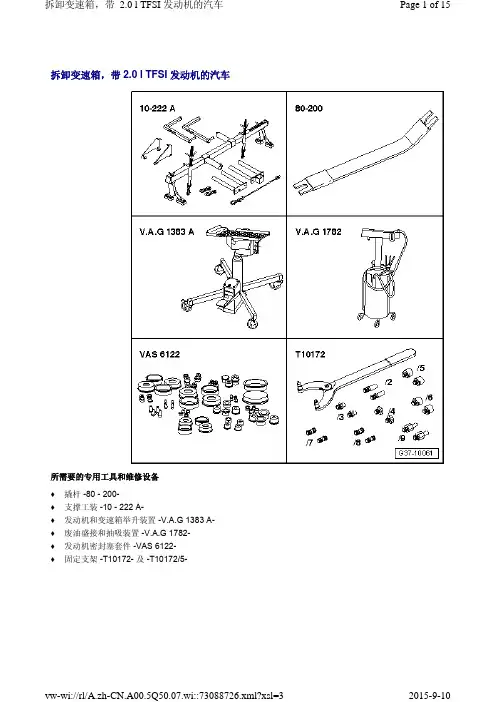
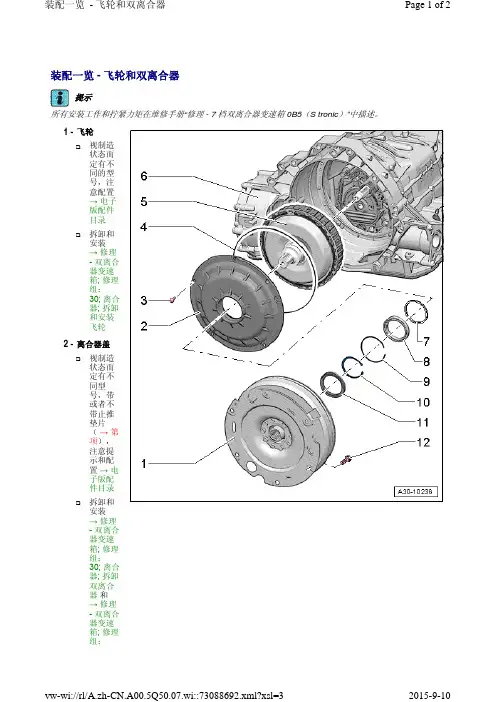
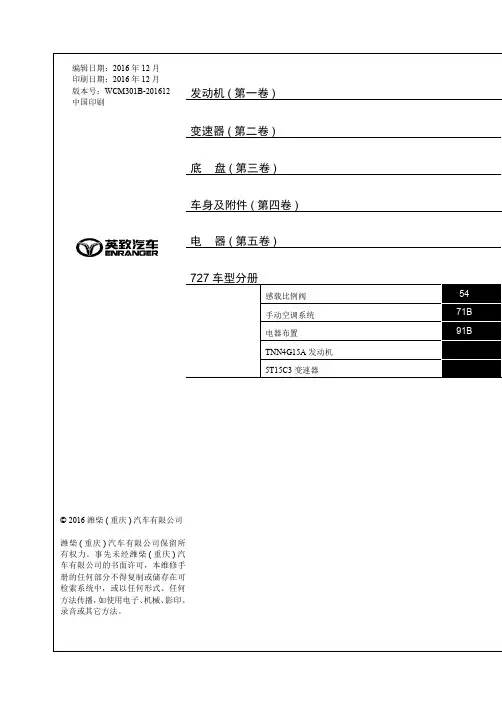

5+1变速器说明书车辆与交通⼯程学院课程设计说明书设计类型专业课程设计设计题⽬ 5+1档变速器设计(有超速档)姓名院系车辆与交通⼯程学院完成⽇期指导教师⽬录第⼀章机械式变速器⽅案的确定................................ 错误!未定义书签。
§变速器传动机构布置⽅案的确定.......................... 错误!未定义书签。
§变速器主要参数的选择................................... 错误!未定义书签。
第⼆章变速器的设计与计算.................................... 错误!未定义书签。
§轮齿强度计算.......................................... 错误!未定义书签。
§轴的计算............................................... 错误!未定义书签。
§轴上花键的计算........................................ 错误!未定义书签。
第三章变速器同步器的设计.................................... 错误!未定义书签。
§同步器的结构.......................................... 错误!未定义书签。
§同步环主要参数的确定.................................. 错误!未定义书签。
第四章变速器的操纵机构...................................... 错误!未定义书签。
第五章润滑与密封............................................ 错误!未定义书签。
§润滑................................................... 错误!未定义书签。

图书基本信息
书名:<<通用汽车自动变速器维修手册>>
13位ISBN编号:9787111132363
10位ISBN编号:711113236X
出版时间:2004-1
出版时间:机械工业出版社
作者:(美国)摩托信息出版公司编、周志立等译
译者:周志立
版权说明:本站所提供下载的PDF图书仅提供预览和简介,请支持正版图书。
更多资源请访问:
内容概要
本书介绍了通用汽车公司1994-1998年款汽车的自动变速器/变速驱动桥,包括:4T60-E和4T65-E自动变速驱动桥和4L60-E自动变速器的维修方法。
内容包括系统的一般知识、维护保养知识、各种控制机构的调整、各种传感器和执行器的测试以及系统试验、故障的诊断程序和方法调整、各种传感器和执行器的测试以及系统试验、故障的诊断程序和方法以及相关的故障码、故障的排除方法、自动变速器/变速驱动桥的解体检修。
配有大量图表,内容详细、实用、全面,描述简洁、通俗易懂,是通用汽车自动变速器/变速驱动桥维修人员必备的工具书,也是相关专业人士了解国外汽车自动变速器技术的难得参考书。
版权说明
本站所提供下载的PDF图书仅提供预览和简介,请支持正版图书。
更多资源请访问:。
![[资料]帕萨特B5手动变速箱维修上](https://uimg.taocdn.com/3d2708b3b52acfc788ebc991.webp)
[资料]帕萨特B5手动变速箱维修上上海帕薩特B5轎車配備的變速箱012/01W是5擋手動變速箱,可安裝在4缸發動機、5缸噴射式發動機和6缸噴射式發動機上。
012/01W變速箱的標誌字母和製造日期:圖1中箭頭1:及變速箱的識別代號:圖1箭頭2:見圖1所示。
其中標誌字母和製造日期代號DJA 15 10 6中DJA代表標誌字母,15代表製造日期,10代表製造月份,6代表製造年份:1996年:。
變速箱的代號還同時標誌在汽車的資料銘牌上。
帕薩特B5手動變速箱012/01W的維修技術資料如表1所示,傳動路線如圖2所示。
修理時的注意事項為了有效地修理變速器,認真仔細、高度清潔和使用合適的工具是一個重要前提,除此之外,一些相關知識的瞭解也是很有必要的。
1〃帕薩特B5的變速箱的材料是鋁合金或鎂合金,螺栓和其他直接與變速箱相接觸的部件,其表面須與鋁制或鎂制變速箱相一致,如果使用錯誤的部件會產生接觸腐蝕,將損壞變速箱。
安裝變速箱時,注意發動機和變速箱之間定位套的正確位置;更換變速箱時,變速器油必須灌滿至注油口邊緣。
2〃變速箱接合面應徹底清潔,並塗上AMV 188 001 02密封劑,密封劑應塗抹均勻,但不要太厚,所有O形密封環、軸密封圈在維修拆裝時必須更換。
裝入密封墊和密封環前,要在外徑上塗上少許潤滑油,在唇形密封圈之間的空隙填滿潤滑脂油;裝入後要檢查變速箱的油面,必要時添加至注油口邊緣。
3〃更換擋圈及鎖圈時不能將擋圈拉開過度,並且必須將擋圈放在槽內。
更換彈簧銷時要注意其安裝位置,開口應沿縱向作用力方向放置,如圖3所示。
4〃緊固蓋板和殼體的螺栓和螺母應交叉擰緊和擰松,特別是易損部件:例如離合器壓盤:要擺正,並分級交叉地擰緊和擰松。
5〃安裝軸承時要將有標誌一面的滾針軸承:壁厚較大:朝向沖銷,安裝在一根軸上的幾個圓錐滾柱軸承必須成套更換,並且盡可能使用相同廠家的產品,為了便於安裝內圈應將內圈加熱到約100?後進行,尺寸相同的軸承內外圈不可互換的,軸承也是成對的,不可搞混。
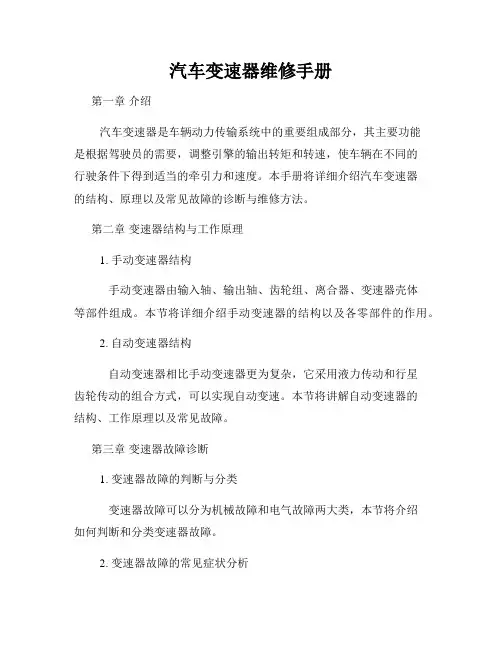
汽车变速器维修手册第一章介绍汽车变速器是车辆动力传输系统中的重要组成部分,其主要功能是根据驾驶员的需要,调整引擎的输出转矩和转速,使车辆在不同的行驶条件下得到适当的牵引力和速度。
本手册将详细介绍汽车变速器的结构、原理以及常见故障的诊断与维修方法。
第二章变速器结构与工作原理1. 手动变速器结构手动变速器由输入轴、输出轴、齿轮组、离合器、变速器壳体等部件组成。
本节将详细介绍手动变速器的结构以及各零部件的作用。
2. 自动变速器结构自动变速器相比手动变速器更为复杂,它采用液力传动和行星齿轮传动的组合方式,可以实现自动变速。
本节将讲解自动变速器的结构、工作原理以及常见故障。
第三章变速器故障诊断1. 变速器故障的判断与分类变速器故障可以分为机械故障和电气故障两大类,本节将介绍如何判断和分类变速器故障。
2. 变速器故障的常见症状分析变速器故障通常会表现为换挡不顺畅、异响、漏油等症状,本节将详细分析不同症状可能的故障原因。
3. 变速器故障的诊断流程在诊断变速器故障时,需要按照一定的顺序进行排查,以确定故障点并采取适当的修复措施。
本节将介绍一套系统的诊断流程。
第四章变速器维修方法1. 变速器常见故障的修复技巧针对变速器常见的故障,本节将分享一些实用的修复技巧。
例如,如何解决异响问题、如何更换磨损严重的啮合齿轮等。
2. 变速器维修的注意事项在进行变速器维修时,有一些注意事项需要遵守,以确保操作安全并有效解决故障。
本节将列举一些重要的注意事项。
第五章变速器保养与维护1. 变速器油的更换定期更换变速器油是保持变速器正常工作的关键。
本节将介绍变速器油的更换方法和频率。
2. 变速器冷却系统的维护高温是造成变速器故障的常见原因之一,保持冷却系统的良好状态对于变速器的寿命至关重要。
本节将介绍变速器冷却系统的维护方法。
第六章汽车变速器常见问题解答在实际使用中,车主对于汽车变速器可能会有一些常见问题的疑惑。
本章将解答一些常见问题,帮助车主更好地了解和使用汽车变速器。

第四章上海帕萨特B5自动变速器及主减速器的维修第一节上海帕萨特B5 01N自动变速器的结构与原理一、01N自动变速器概述上海帕萨特B5自动变速器是全自动的四档变速器,在选定的区域内所有的档位都是自动切换的,换档是通过一个电子液压器件和控制单元进行的。
该自动变速器外壳是一个整体式外壳,在投入使用的第一年一般不需要对变速器进行维修,超过一年后,可对行星齿轮轮变速机构的阀体、片式离合器、片式制动器根据所诊断的故障进行维修或更换,01N自动变速器外观如图4-1所示。
01N自动变速器由液力变矩器和变速器组成。
液力变矩器中装有锁止离合器,锁止离合器根据车辆的负载、速度和档位的状况机械性地闭合,与打滑无关。
该4档自动变速器子01N有4个液压控制的前进档,当锁止离合器闭合时,这些前进档由液力变矩器的打滑转变成机械驱动的档位。
其组成如图4-2所示,其结构如图4-3所示。
自动变速器只有在P或N档时,发动机才能起动。
对于装备自动变速器的汽车不能通过推动或牵引汽车来起动发动机,这是因为变速器工作所需要的来自ATF油泵的工作油压只有在发动机运转时才能建立。
装备自动变速器的汽车当换档杆位于N档时,汽车可以被牵引。
但牵引时,牵引速度不能超过50km/h,牵引距离不能大于50km,如果距离更远,则需要将汽车前部抬起,这是因为发动机停止运转时,变速器的旋转零部件将得不到润滑。
图4-1 01N自动变速器外观图图4-2 01N自动变速器示意图1-第2和第4档制动器B2 2-倒档离合器K2 3-第1至第3档离合器K1 4-第3至第4档离合器K3 5-倒档制动器B1 6-自由轮离合器7-装在液力变矩器内的锁止离合器图4-3 变速器结构图二、上海帕萨特B5自动变速器的结构和原理(一)换档杆的结构换档杆有P(驻车锁止)、R(倒档)、N(空档)D(前进档)、3、2、1共7个位置,在换档杆旁有带运动型指示灯的ECO/SPORT(经济型/运动型)行驶方式的选择按钮,通过该按钮,驾驶员能够选择低耗油(经济型)和高功率(运动型)的两换档模式。
Shifting the 5 SpeedThe fully synchronized manualtransmission is very easy to shiftup or down. When you slow downfor traffic, steep hills, or corners,shift to a lower gear before theengine starts to labor. When de-scending steep grades, select alower gear to help maintain a safespeed and to prevent the brakesfrom overheating.When shifting, depress the clutchpedal fully, shift gears and then release the clutch gradually. Do not speed-shift; allow time for the gears to synchronize.To prevent grinding the gears when shifting into reverse, hold the clutch pedal depressed briefly before shifting, or shift the lever into one of the forward gears before selecting reverse.A safety lockout prevents accidental shifting straight from 5th to Reverse.Avoid rapid acceleration or sudden deceleration when either or both driving wheels are on a slippery surface. Decreased traction could cause loss of directional control.CAUTION:Do not drive with your foot on the clutch pedal as this will causepremature wear of clutch components.Do not shift into reverse while the car is moving.(cont'd)Shifting the 5 Speed (cont'd)Maximum Allowable SpeedsThe speeds shown below are the maximum at which the car can be driven or downshifted in each gear without over-revving the engine.Recommended Shift SpeedsFor best fuel economy, and effective emission control, shift at the speeds shown:Shifting the AutomaticThe automatic transmission shift lever has a locking mechanism to prevent accidental shifting into Reverse (R), Park (P) or 2nd (2). Also,an Automatic Shift Lock prevents you from shifting out of Park unless the brake pedal is already depressed and the ignition switch is in the II position.Push the button on the shift handle to shift into 2nd, Reverse or Park; depress the brake pedal and then push the button on the shifthandle to shift out of Park.: Depress the brake pedal firstand push the button, then shift.: Push the button, then shift.: Shift as desired.If you cannot shift out of Park with the brake pedal depressed and the ignition switch in the II position:1.Turn the ignition switch off and remove the key.2. Insert the key in the Shift Lock Release located to the right of the shift lever.3. Press and hold the key down,then press the button on the shift handle and move the shift lever to Neutral.4. Return the key to the ignition switch, depress the brake pedal and restart the engine.NOTE:If you encounter any problem shifting out of Park, have your authorized Honda dealer check the system as soon as possible.Depress buttonInsertSHIFT LOCK RELEASEKEY(cont'd)Operating TipsFor smoother operation, apply the brakes when shifting from Neutral or Park to a forward or reverse gear.When parking: bring the car to a stop with the foot brake, hold the brake on and shift into Park, set the hand brake and then turn off the engine.NOTE:Your 4 speed automatic transmission is equipped with a torque converter lock-up clutch. Because of this, you may notice what feels like an extra shift as the clutch engages.CAUTION:Shift into P only after the car has come to a complete stop.Shift into or out of R only after the car has come to a complete stop.Do not "rev-up" the engine when the brake is on and the shiftlever is in D, S, 2 or R.When stopped on a hill, use the brakes to hold your position, not the accelerator pedal.Do not shift from N or P into D, S, 2 or R when the engine is above idle speed. Before shifting into gear, make sure your footis firmly on the brake pedal.Do not rest your hand on the shift lever or push the shift button while driving.Driving TechniqueD-4thUse the D range for normal in-town and highway driving. The car will start off in 1st and shift automatically to 2nd, 3rd, and 4th. The further down you push the accelerator, the later the transmission will shift and the faster the car will accelerate.S 3 / S 4The "S " shift selector range changes the shift points under part throttle acceleration, allowing the transmission to stay in each lower gear for a longer period before automatically upshifting. With the shift selector in the "S " range, the "S 3" indicator light in the instrument panel will come on and the transmission will shift from 1st to 2nd and 3rd but not 4th. This is especially useful when climbing or descending grades. While driving in the "S " range, the car's performance is improved but fuel economy is reduced.Shifting the Automatic (cont'd)While driving in the "S " range, you can select 4th gear by pushing th e "S 4" switch. Depending upon vehicle speed and throttle pedal position, the transmission will shift to 4th gear when the switch is pressed ; the "S 4" indicator light in the instrument panel will come on . Pushing the "S 4" switch again will cause the transmission to downshift to 3rd gear in the "S 3" mode. The "S 4" indicator light in th e instrument panel will go out, and the "S 3" light in the instrument panel will come on I f the shift lever is moved to any other driving range, the "S 4".switch will be cancelled automatically.NOTE:In both the D and S modes, the transmission holds in 2nd while you are stopped in gear. When you start moving again, thetransmission shifts to 1st, then 2nd and so on.If rapid acceleration is necessary, depress the accelerator to the floor; the transmission will automatically shift down according to load and engine speed. This applies to both D and S ranges.(cont'd)S 4SWITCH2-2ndUse 2nd gear for increased engine braking when driving downhill,and increased power when driving uphill; also for driving on slippery roads, and freeing the car from mud or sand, where 1st gear could provide too much power and cause skidding or wheelspin. The maximum recommended speed in 2nd gear is:60 mph (97 km/h)R-Reverse CAUTION:Shift into or out of reverse only after the car has come to a complete stop; the transmission may be damaged if you shift while the car is moving.P-ParkCAUTION:Use this position when starting the engine, or when parking. Shift into Park only when the car is COMPLETELY stopped.N-NeutralUse when starting the engine or during prolonged idling in traffic.Shiftin gthe Automatic (cont'd)Towing a TrailerYour car is designed primarily to carry passengers and a normal amount of luggage. Although your car is capable of towing a trailer, there will be an effect on handling, performance, braking, general vehicle and tire durability and fuel economy.The weight of the trailer plus its cargo must not exceed a totalof 1,000 Ibs. (450 kg).The gross vehicle weight must not exceed the Gross VehicleWeight Rating (GVWR) indicated on the Certification label (see page 131 ). The gross vehicle weight is the total weight of the car, driver, passengers, luggage, hitch and trailer tongue load.The total weight supported by each axle must not exceed theGross Axle Weight Rating (GAWR). The front and rear GAWR's are shown on the Certification label (page 131 ). The distribution of luggage and passengers in the car, as well as the tongue load and hitch weight should also be considered in terms of the GAWR, which is the maximum amount of weight that should be supported over the front and the rear axles. You should have your car and trailer weighed at a commercial weighing station to check both the GVWR and GAWR's to confirm that the total weight and weight distribution are within safe driving limits.The maximum trailer tongue load must not exceed 100 Ibs. (45kg). Cargo should be distributed so that the tongue load is approximately 10% of the total weight of the trailer and its cargo. This is done by distributing approximately 60% of cargo weight toward the front of the trailer and 40% toward the rear.TRAILER WEIGHT TONGUE LOADMaximum: 1,000 Ibs (450 kg)Maximum: 100 Ibs (45 kg)Never load the trailer so that the back is heavier than the front.This will seriously affect vehicle handling. Be sure the cargo is secured so that it will not move during driving.(cont'd)Towing a Trailer (cont'd)HitchesUse only a hitch recommended by your Honda dealer. The hitch should be bolted securely to the car and installed by a qualified technician. Do not use a hitch designed for temporary installation and never use one that attaches only to the bumper.Trailer Brakes and Safety ChainsThe Honda Automobile Division recommends that trailers equipped with brakes should conform to any applicable federal and state regulations. When using a trailer equipped with electric brakes, a trailer brake controller that connects to the car's electrical system is recommended. Installing a brake controller that connects to the car's brake hydraulic system could result in brake fluid contamination or leaks. A safety chain must always be used between the car and the trailer. Leave sufficient slack in the chain so that it does not bind in sharp turns. The chain should cross under the trailer tongue to prevent the tongue from dropping to the ground.TiresMake sure your car's tires are properly inflated. Adjust tire pressure to the recommended tire pressure indicated on the label attached to the edge of the driver's door. The trailer tires should be of the proper size, load rating and inflated to the pressure recommended by the trailer manufacturer.Trailer LightsTrailer lights must comply with federal, state and local regulations. See your local recreational vehicle dealer or rental agency for the correct type of lighting and wiring for your trailer. Check for correct operation of the turn signals and stop lights each time you hitch up.CAUTION:Connections to your car's electrical system should be made by your Honda dealer or a qualified electrician. Improper installation may damage your vehicle's electrical system and cause a malfunction of the lights.Break-in ScheduleDo not tow a trailer during the 600 miles (1,000 km) break-in period: see page 2 .MaintenanceIf you tow a trailer, your vehicle will require more frequent maintenance due to the additional load. Refer to the "Maintenance schedule under severe driving conditions" on page 82 for specific information.Before TowingWith the car and trailer completely loaded and parked on a level surface, confirm that the tongue loading is correct. If the car has an abnormal nose-up or nose-down attitude, check for improper cargo distribution. Check also for excessive cargo weight, worn suspension or other causes and correct the problem before driving. Be sure the cargo is secured so it will not shift while driving. Check that your rearview mirrors conform to any federal, state or local regulations. If not, install rearview mirrors designed for towing. Before towing a trailer, practice turning, stopping and reversing with a trailer in an area away from traffic until you learn the technique.(cont'd)Towing a Trailer (cont'd)Towing SafetyStopping distance will be increased when towing a trailer. Foreach 10 mph (16 km/h) of speed, allow at least two car lengths between you and the vehicle ahead. Avoid sudden braking which may cause trailer jackknifing and loss of control.Avoid jerky starts and sudden acceleration. If your car has amanual transmission, always start out in first gear and release the clutch at moderate engine rpm.Avoid rapid lane changing and sharp turns. The trailer could hityour car in a tight turn. Slow down before making a turn. Remember, the total length of your car plus trailer will require a wider turning circle.Crosswinds may adversely affect handling of your car andtrailer. Use the rearview mirrors frequently to warn you of approaching large vehicles that may pass you causing your car and trailer to sway. When being passed, firmly grip the steering wheel and be prepared to reduce speed immediately but gradually. Never increase speed. Steer straight ahead.Towing a trailer in bad weather will magnify any difficulty incontrolling the car caused by the weather itself. Avoid sudden maneuvers: slow down and use extra caution.Be careful when passing other vehicles. Passing requiresconsiderable distance because of the added weight and length of your trailer.CAUTION:Before starting out, check the operation of the lights and all car/trailer connections. After driving a short distance, stop and recheck the lights and connections.Reversing is difficult and requires practice. While backing-up,the trailer may pivot off-course. To correct for this, grip the bottom of the steering wheel and move your hand to the left to move the trailer to the left; or to the right to move the trailer to the right. Turn the steering wheel a little at a time, and keep thespeed very low. Have someone guide you when backing.To help prevent overheating of the brakes, shift into a lower gear to make use of engine braking before descending steep orlong grades. Do not make sudden downshifts.Pay strict attention to the coolant temperature gauge when going up hills. Because of the added load of the trailer, your car's engine may overheat on hot days. Turning off the air conditionerwill reduce the load on the cooling system.On cars equipped with automatic transmission. '— Do not hold the car stationary on an incline by using the accelerator pedal; this can cause the transmission fluid to overheat. Instead, use the handbrake or foot brake.— When towing trailers, avoid high transmission fluid temperatures (caused by the transmission frequently shifting between 3rd and 4th gears) by driving in S 3.NOTE:Be sure to check state and local laws concerning maximum speed or other driving restrictions for cars towing trailers. If you are driving across several states, check each state's requirements before leaving home, because restrictions may vary,Parking with a Trailer Whenever parking your car on an incline with a trailer attached,place and seat chocks at each wheel of the car and trailer. This is in addition to the normal parking preparations of firmly applying the parking brake and placing the transmission in first or reverse (manual transmission) or P (automatic transmission).CAUTION:Parking on an incline is not recommended and should be done only if it cannot be avoided. Follow all precautions mentioned above and turn the wheels to point towards a curb if facing downhill,away from a curb if facing uphill. When leaving an inclined parking place, move the car slightly to unseat the chocks. Then while keeping the foot brakes firmly applied, have an assistant removethe chocks.。
HW25505T变速器维修手册大同齿轮公司2011年8月目录目录 (2)第一章HW25505T系列变速器的拆装 (3)第一节HW25505T系列变速器的拆装的基本要求 (3)第二节变速箱拆装 (4)2.1从整车上拆卸变速箱总成 (4)2.2 变速箱总成的拆装 (4)2.3轴总成的拆装 (7)2.4后盖总成的分装 (10)2.5小盖总成的拆装 (11)2.6拨叉轴总成的装配 (12)第二章维修注意事项 (14)第三章常见故障及排除 (15)第四章维修工具 (16)第一节专用工具清单 (16)第二节通用工具清单 (16)第一章HW25505T系列变速器的拆装第一节HW25505T系列变速器的拆装的基本要求变速箱拆卸的基本要求如下:○1分解变速箱总成之前,必将变速箱外壳彻底清洗干净;○2变速箱的分解必须在一个清洁的地方进行,避免让灰尘或其它杂物进入变速箱内部,否则会加剧磨损和损坏轴承;○3拆卸轴承要使用专用工具,拆下的轴承要仔细的清洗;○4分解各个分总成时,要把所有零件按拆卸时的顺序放在干净的工作台上,避免零件丢失,又便于装配;○5拆卸卡簧应使用卡簧钳;○6在拆卸零件过程中,一定要注意施加在轴或壳体等零件上力量的大小,请勿野蛮操作,避免损坏零件,有些零件是禁止拆卸的,绝对禁止向正在运转的从动件施加外力。
⑦拆卸某些部件必须使用专用工具,使用专用工具时参考本维修手册及专用工具说明书。
变速箱装配过程中的基本要求:○1熟悉装配要求、所要装的零部件的外观形状,正常的零件装完后所处的位置,防止个别的不合格品的使用。
○2装配前做好零件自检,检查所要装的零件,保证表面的清洁及无明显制造缺陷,尤其重要结合面部不得有毛刺、磕碰伤等,如:油封的配合面及装配时的过渡面,齿轮齿面不得有明显磕碰等。
○3拿零件时要轻拿轻放,不得碰伤零件的表面、尤其是重要结合面。
○4装完零件后,零件表面如果被零铜锤等敲击,要把零件表面上残留的铜屑擦除干净,保证零件表面的清洁。
捷达5速变速箱维修手册一、拆解步骤1卸下放油螺栓•拆卸变速箱前准备▲桜变速箱用g用工貝VW3(W和VW353固定到专用支架上左▲秋出变速箱油]■向下拉出离合器压杆。
2卸下倒档开关■拆下倒掛锁止螺栓血拆卜⑱抄领止螺拴'倒样锁止螺性位置如图所示◎3用专用工具固定输入轴及半轴4拆下半轴法兰盘(使用专用工具)■拆卸弹性挡圈▲用卡黃甜将弹性挡圈柝■拆卸驱动法兰▲用阴个MR 栓.将专用工具VW391 固定u▲用梅花扳手,拧动专用工具的螺杆,貢至将驱动法兰拉出“5拆卸离合器盖当銮速箱总成从车I-.拆下后’将其首丁变速箱专用拆装支架上.就可对其内部 零件进行拆出J 由二五峪变速鶴比曲摘变迷箱增加了 •个挡位,冈此作为壳体被分■拆卸变速箱壳休端盖止拆下蛭栓1和憔栓茲 ▲拆下变速箱壳体端壽九 基拆下密M®n tA#上倒挡、拆卜嚟栓1山虚拆下予描换皆拨叉監 虚拆下锁紧烘鑒 ▲拆下弹性挡圈5和止推垫圈6;: ▲拆下5挡上动齿轮九6拆卸换挡轴止动螺栓及换挡轴■拆卸挡盖血用专用工具U - 20020和飯手将挡盖 拆下,应二部分.增加了变速箱喘体端盖[-六角聘栓.力矩2,% 2-Aifi!^栓Jj® 25N ・m 3 -变速箱端在淖瑞盖4-5 R 曲动国套/同歩器垢莪 5-弹件 撐圈 召_1卜推培圈 7 卞动齿轮E-颉紧块 5-5 换罚拨史 乂-喋 桂 JjHI 150\ 5”11 -潜剽起■拆卸变速売外部件▲从换宿杆上拆下盖A o▲拆下止动螺栓爲危拆卜嚮栓2*芥取F里程表机构°■锁住变速箱赢沿笛头1的方向向下移动滑套挂人5▲沿箭头2的方向向下移动换掛拨里便倒挡7同时挂上两个档位(五档倒档)齿轮啖合“8用专用工具拆卸五档锁止螺母(注意力矩比较大)9用专用工具拆卸五档调整螺母10拆卸五档总成・5扌当同步器总成固定螺栓位置▲騎头所示位迓为5挡同歩器总成固定螺栓位罟召■拆卸5挡同步器总成固定蚁栓▲用专用工具U -40020 人固定螺栓* 将其拆F,■拆卸止动垫圈▲用腫把摞丝刀,撬下转接管的止动垫"拉出壳体(注意拨叉轴)■拆下转接管▲用专用工具3059,向左转动转接管,将其W 一3059从换挡拨叉上拧卜。
Transmission Fluid, Brake and Clutch Fluid5-speed Manual TransmissionCheck the fluid level with the transmission at normal operating temperature and the vehicle sitting on level ground. Remove thetransmission filler bolt and carefully feel inside the bolt hole with your finger. The fluid level should be up to the edge of the bolt hole. If it is not, add Genuine Honda Manual Transmission Fluid (MTF) until it starts to run out of the hole. Reinstall the filler bolt and tighten it securely.If Honda MTF is not available, you may use an API service SG or SH grade motor oil with a viscosity of SAE 10W-30 or 10W-40 as atemporary replacement. However,motor oil does not contain the proper additives and continued use can cause stiffer shifting. Replace as soon as convenient.The transmission should be drained and refilled with new fluid according to the time and distance recommen-dations in the maintenance schedule.Brake and Clutch FluidCheck the fluid level in the reser-voirs monthly. There are one or two reservoirs, depending on model.They are:Brake fluid reservoir (all models)Clutch fluid reservoir(manual transmission only)The brake fluid in the brake system should be replaced according to the time and distance recommendations in the maintenance schedule.MaintenanceFILLER BOLTCorrect levelBrake and Clutch FluidBrake FluidAlways use Genuine Honda DOT 3brake fluid. If it is not available, you should use only DOT 3 or DOT 4fluid, from a sealed container, as a temporary replacement. However,the use of any non-Honda brake fluid can cause corrosion and decrease the life of the system. Have the brake system flushed and refilled with Honda DOT 3 brake fluid as soon as possible.Brake fluid marked DOT 5 is not compatible with your car's braking system and can cause extensive damage.Brake SystemThe fluid level should be between the MIN and MAX marks on the side of the reservoir. If the level is at or below the MIN mark, your brake system needs attention. Have the brake system inspected for leaks or worn brake pads.Clutch SystemThe fluid should be between the MIN and MAX marks on the side of the reservoir. If it is not, add brake fluid to bring it up to that level. Use the same fluid specified for the brake system.Low fluid level can indicate a leak in the clutch system. Have this system inspected as soon as possible.MaintenanceMAXMIN MINMAX。
长安铃木5AT变速箱维修案例
一、车辆情况:维修时间:XXXX年XX月XX日,客户:XX郑先生,车型:XXX,变速箱:6档手自一体,行驶里程:11万公里。
二、故障现象:行驶中自动变速箱异响,师傅经过试车发现确实有此问题。
铃木启悦变速箱异响,传星自动变速箱维修
三、变速箱故障:自动变速箱异响情况较为复杂(因为有很多零件的损坏都会引起异响故障),师傅首先要做的是判断异响部位。
异响主要可分为三个部位产生,轴承异响、差速器或主转动齿轮异响、油泵等液压系统异响。
对该车做了一系列的专业检测后,师傅初步判断故障是由于轴承损坏导致的。
四、变速箱维修:检查轴承,发现中壳轴承磨损严重,已无法继续使用。
更换中壳轴承,油格,并更换输入轴齿轮。
清洗其他零件后,复装试车,故障排除。
东南(福建)汽车工业有限公司
5T15C 汽 车 变 速 器
维修手册
目录
一、5T15C变速器总成结构图
二、主要技术参数
三、变速器装配关系示意图
四、变速器结构分解图
五、使用/操作方法及注意事项
六、常见故障及排除方法
一、5T15C变速器总成结构图:
二、主要技术参数:
-
4 1-选换挡机构总成 2-分离拨叉及分离轴承 3-输入轴总成 4-变速器壳总成 5-惰轮及惰轮轴 6-离合器壳总成 7-输出轴总成 8-差速器总成 9-换挡拨叉总成
三、装配关系示意图:
-
四、变速器结构分解图:
1、传动系统分解
(1) 输入轴总成分解图
1——五倒档同步器总成2——五倒档同步器齿套3——五档主动齿轮4——四档主动齿轮5——四档滚针轴承半挡环6——挡环-四档滚针轴承7——三四档同步器总成8——三档主动齿轮9——三四五档滚针轴承10——输入轴
11——输入轴前轴承12——输入轴后轴承13——三档同步环14——三四档同步器齿套15——三四档同步器齿毂16——三四档同步器卡环17——四档同步环18——五档同步环19——三四五档同步器滑块20——衬套-输入轴挡油板21——输入轴挡油板 22——三四五档同步器弹簧
23——倒档同步锥环24——倒档同步锥25——五倒档齿毂26——五倒档同步器卡环
(2)输出轴和差速器总成分解图
1——差速器油封 2——差速器轴承
3——里程表主动齿轮 4——差速器组件
5——惰轮组件 6——惰轮垫圈
7——惰轮轴 8——一档从动齿轮 9——主减从动齿轮 10——惰轮紧固螺钉 11——输出轴前轴承 12——五档从动齿轮 13——双联齿轮 14——二档从动齿轮 15——一二档同步器 16——输出轴
17——输出轴后轴承
注意事项:
1、零件装配前应清洗干净,保证箱体内的清洁度以保证变速器的使用寿命。
2、安装过程中应小心,避免油封划伤漏油。
可用专用护套保护。
3、涂密封胶前必须清理结合面,防止漏油。
4、装输入轴油封、差速器油封时,在油封的唇口处涂上润滑脂,用专用工具将油封充分压入到壳体内。
五、使用/操作的方法及注意事项:
1、换档时应将离合器踏板完全踩下,使变速器脱开发动机扭力后迅速操纵变速杆换档。
2、下坡和转弯时应采用慢速档,不允许离合器分离滑行。
3、当变速器从低档向高档换档时,不要跳档操纵,否则将影响同步器的使用寿命。
4、严禁在空档熄火状态下,利用同步器强行挂档起动发动机,否则将影响同步器的使用寿命。
5、换档时严禁使用拍打的方法(即一推一松的操作方法),应该始终用手按住变速杆,这样能大大地减少同步器锁环的滑摩时间并减少磨损。
6、行驶时,不能将手放在换档杆上,否则会造成换档拨叉过早磨损。
7、使用中发现变速器有异常声响,操作明显沉重等不正常现象时,应立即停车检查,待排除故障后再继续行驶。
8、运行中换档必须选好换档时机,增档前,应首先进行汽车加速(所谓“冲车”),当车速升高到一定值时,及时挂入高速档;降档时,当车速降到一定值时,方可
挂入低速挡。
在确保安全情况下,应尽量使用高速档,以减轻机件的磨损和降低油耗,并且根据路面及交通情况及时调整车速。
9、本变速器在出厂时因为结构没有添加润滑油,需要汽车生产厂家加油2.1L 。
六、常见故障及排除方法:
故障情况 可 能 原 因 排除方法
输入、输出轴轴承损坏 更换轴承
齿轮齿面磕碰、有毛刺或齿面发生点蚀或接触不良修复或更换齿轮 齿轮轴向位置和间隙不当 检查、调整
油面太低,润滑不够充分 加油至规定位置
噪声过大或异常 总成内有异物 检查、排除
油封过量磨损或损坏 更换
密封胶涂敷不均匀或密封垫损坏 更换密封垫、涂胶
结合面磕碰未及时修平 检查、修复
渗油 差速器油封损坏 更换
离合器调整不当,分离不够彻底 调整
换档传动系调整不当或发生运动障碍 检查、调整
换档困难 同步器同步环失效 更换
同步器齿套或齿轮结合齿锥面磨损 更换有关部件
掉档 换档传动系调整不当 检查、调整
换档传动系松动 检修
无档 换档臂总成松动 修复
润滑油含金属杂质 更换
润滑不充分或润滑油不符合要求 更换
轴承非正常损坏 使用不合格的轴承 更换
换档拨叉机构总成上倒档摆臂磨损 更换
倒档跳档 齿轮磨损 更换。